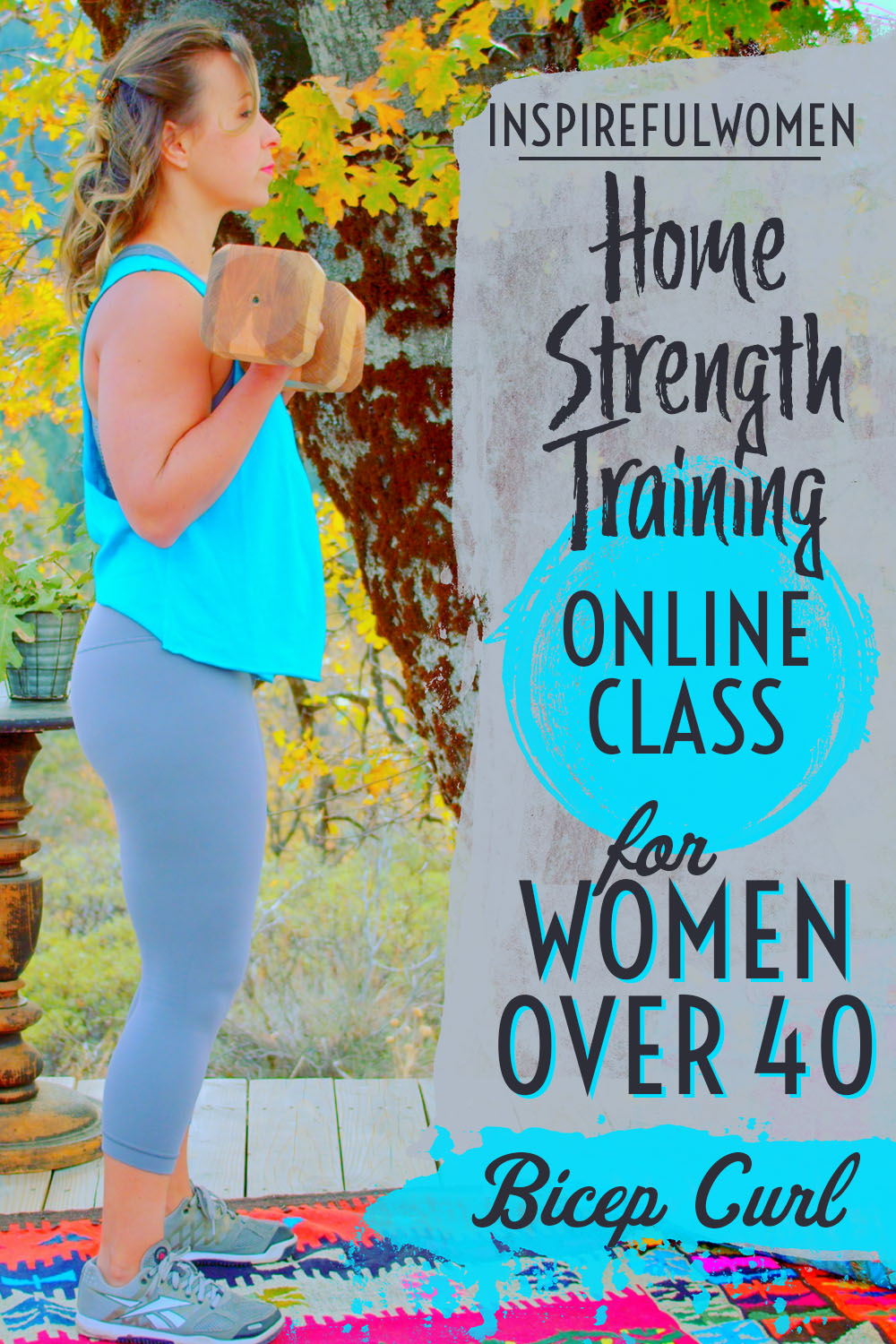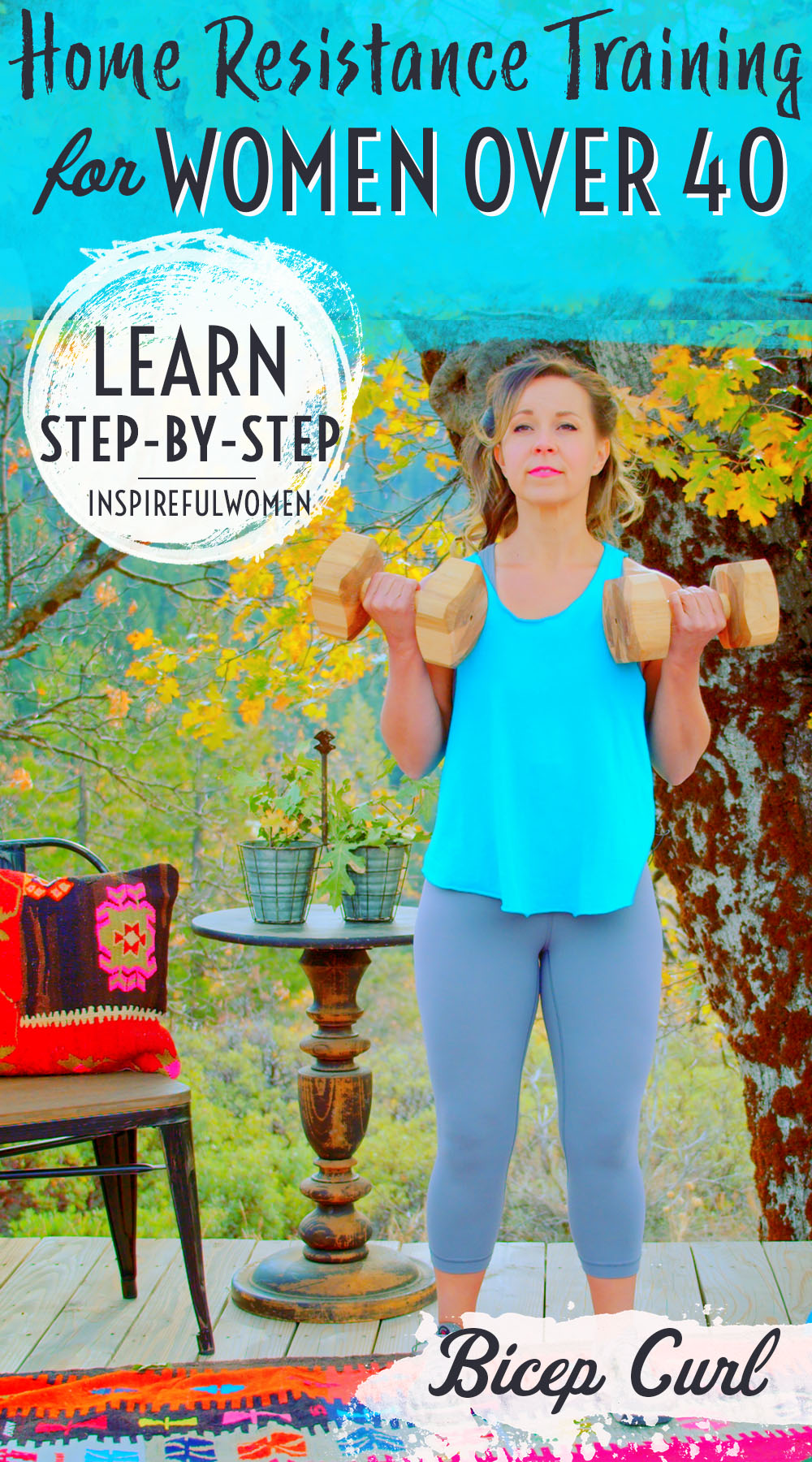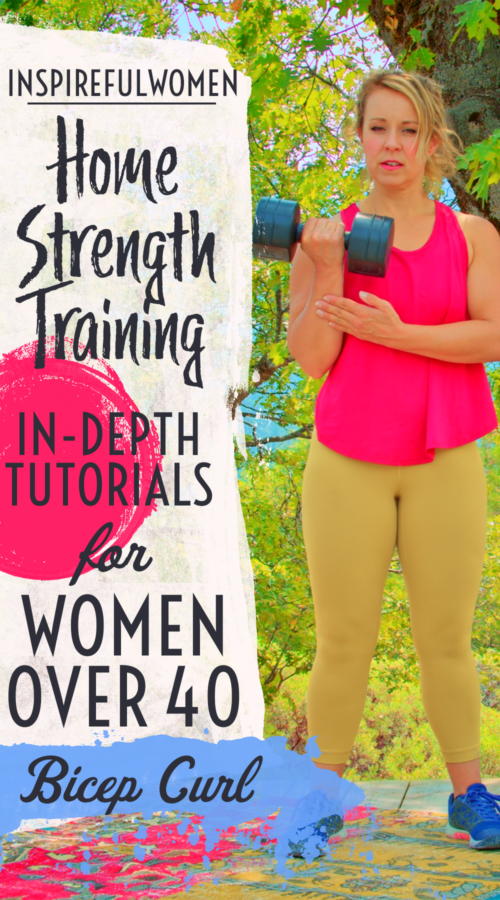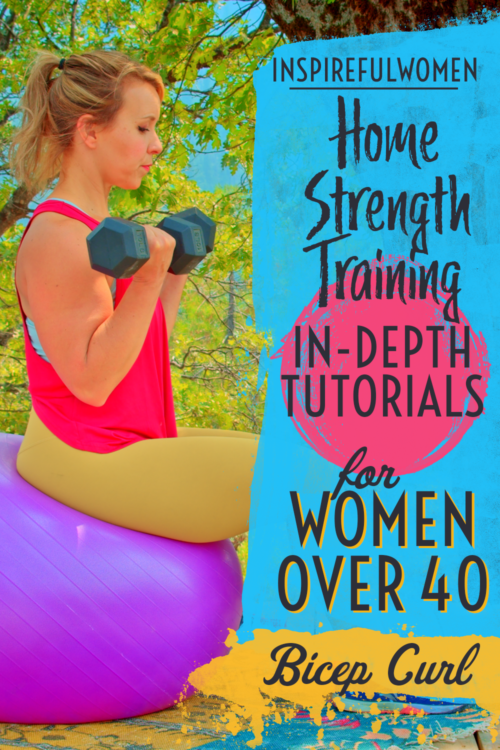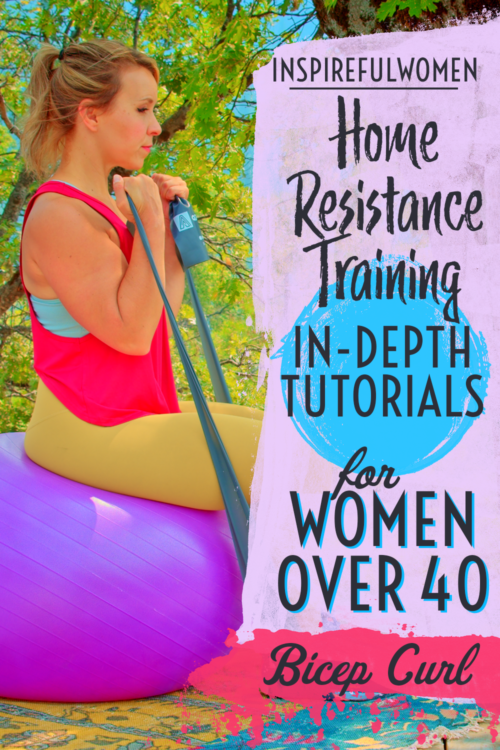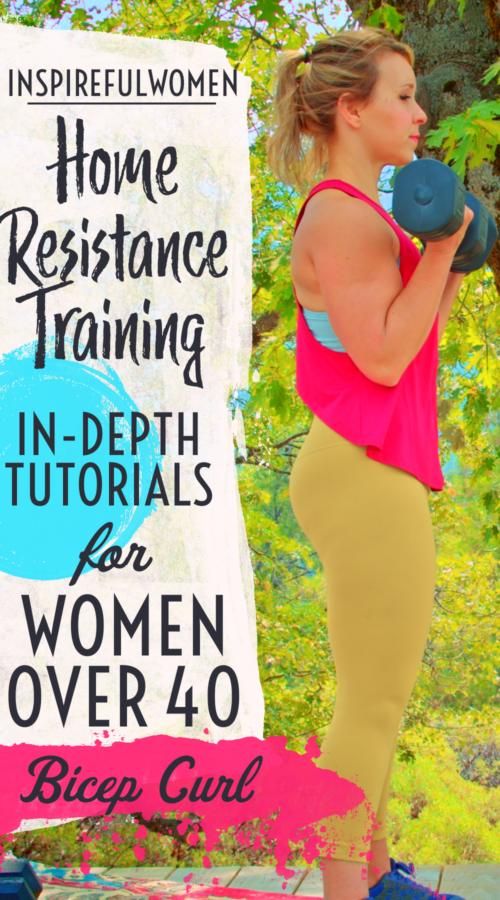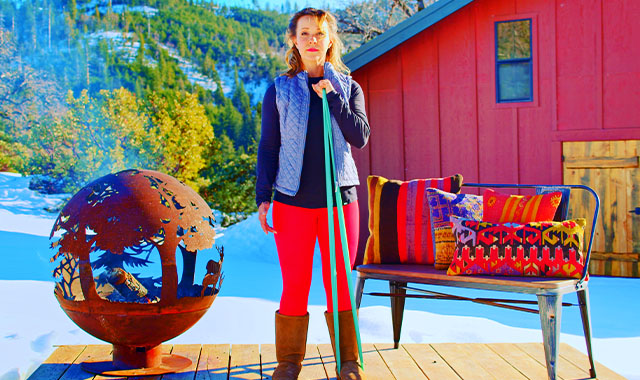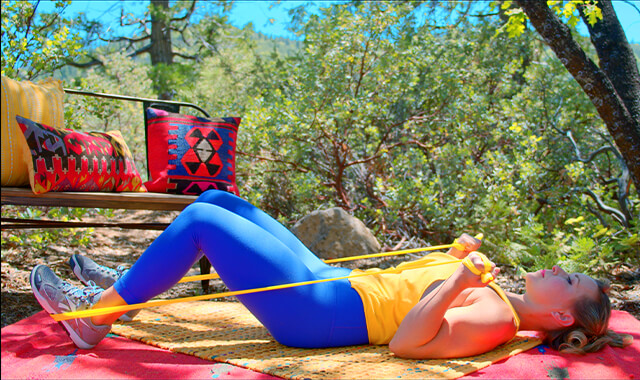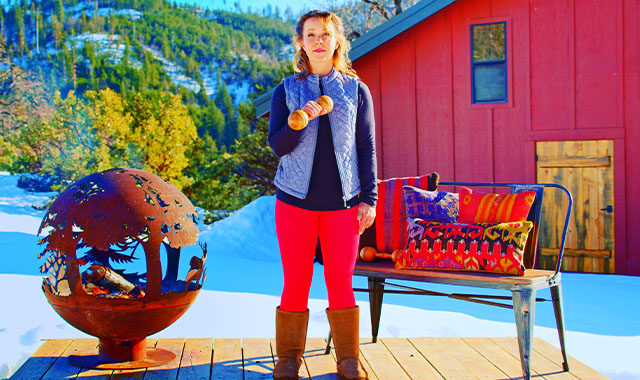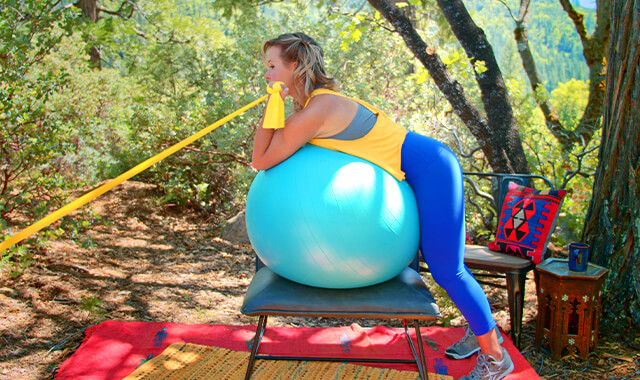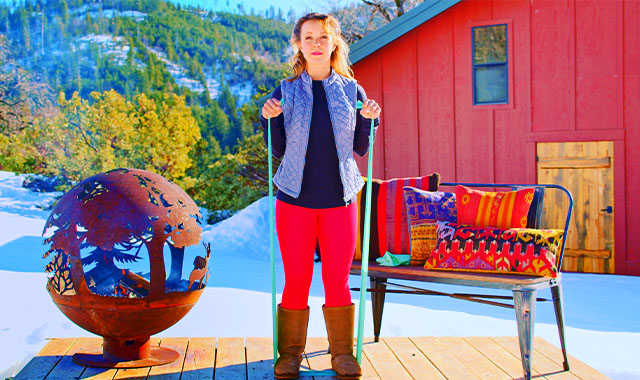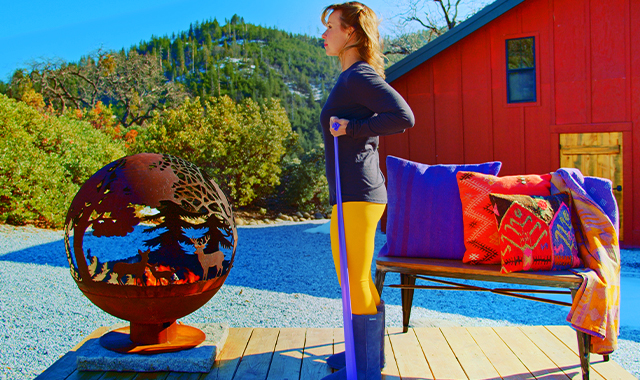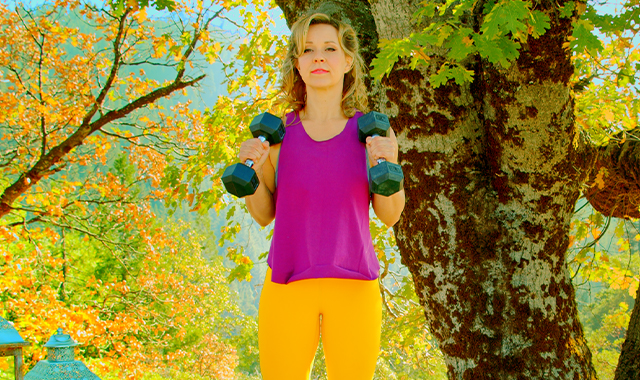Dumbbell Bicep Curl
How to Do the Dumbbell Bicep Curl | In-Depth Guide [VISUAL LEARNERS]
Proper Form, Common Mistakes, Variations + Easier & Harder | Home Resistance Training
WHAT DO YOU WANT TO SEE?
QUICK DEMO
QUICK DEMO
MUSCLES THIS WORKS
MUSCLES
MAIN MUSCLES WORKED IN THE DUMBBELL BICEP CURL
BICEPS BRACHII
OTHER MUSCLES WORKED:
- FOREARMS (supinator)
- Brachialis
WHAT WE'RE DOING TODAY
WHAT & WHY
BENEFITS OF TRAINING YOUR BICEPS MUSCLES
WHAT
Other names for this exercise: Dumbbell Curls, Supinated Grip, Rotating Bicep Curl
WHAT WE'RE DOING TODAY
ALL WE'RE DOING:
A simple bicep exercise, basically, bending your elbows while holding weights.
The biceps brachii (bicep means that the muscle has two heads connecting at different places, and brachii - meaning arm) is the big muscle lying on the upper part of the front of the arm - between the elbow and the shoulder. This is probably the most well-known muscle of the arm - sometimes referred to as the beach muscle. The main function of the biceps brachii (not to be confused with the biceps femoris which is one of the hamstring muscles) is to bend (flex) the elbow, moving the hand closer to the body.
The biceps brachii also can rotate the forearm so that the palm is facing up. The rotation of the forearm is due to one of two long bones in the forearm rotating across the other. This is called supination.
Most of the exercises for the biceps muscle most effectively are movements that combine bending (flexing) the elbow with rotating the forearm to a palm-up position (supination). The bicep is a big, powerful muscle. Exercises that target this muscle can usually be done with quite a bit of resistance.
WHY BOTHER DOING IT?
WHY
WHY DO WE EVEN CARE?
Crossfitting for 8 years we never did specific bicep work, and most of the movements didn’t really work your biceps much. Once I started doing bicep curls regularly, I noticed a big difference. One day I needed to carry a 5-gallon bucket of stuff in each hand for quite a long distance. I was amazed at how much easier it felt than a while back! That’s from the biceps being stronger. This is also helpful for holding other things in your arms - a stack of books, children, getting all the groceries into the house in one trip, pulling heavy pans full of turkey and potatoes out of the oven, carrying a load of firewood, or a stack of lumber.
The biceps brachii crosses the shoulder joint, so it is able to lift the arm up (shoulder flexion). Since it crosses both the elbow and the shoulder it plays a role in stabilizing those joints. The job of the arm is to move the hand to where it needs to be, and then to hold the arm still as the hand does what it needs to do. The biceps is extremely important for both moving the arm through an endless number of positions and holding it still. Strong biceps will make everyday life activities easier and will improve the health of your elbows and shoulders.
EVERYDAY LIFE
EVERYDAY LIFE &
MUSCLE FUNCTION
HOW WE USE OUR BICEPS IN EVERYDAY LIFE
1. BENDING THE ELBOW (ELBOW FLEXION)
- Eating
- Lifting glass for drinking
- Dressing
- Lifting
- Carrying
- Washing/brushing hair
- Stirring
- Painting
- Brushing your teeth
- Weeding
- The list is pretty much endless...
2. TURNING YOUR FOREARM UP (SUPINATION)
- Turning a doorknob
- Using a screwdriver
- Turning a key
- Turning a spigot
- Receiving change
- Carrying a plate
3. LIFTING THE ARM (SHOULDER FLEXION)
- Reaching up
- Dressing
- Pushing a window up
- Washing windows
- Lifting up to the front - kids, boxes
- Carrying in front: kids, groceries, books
4. STABILIZING THE ELBOW AND SHOULDER
- Writing
- Knitting
- Reading a book
- Using a screwdriver
- Holding items in front of you - carrying a heavy box, pushing a wheelbarrow
HOW TO FEEL WHAT MUSCLE IS WORKING
HOW TO FEEL WHAT MUSCLE IS WORKING
Bend your elbow. Place the other hand on the upper arm with the bent elbow. Lift a heavy object with the arm - you will feel the biceps contract under your hand.
HOW TO DO THE EXERCISE
LOOKS
HOW BICEP CURLS SHAPE OUR BODY
Bicep curls will tone and give you muscle definition in the front of your upper arm (where your bicep is haha!)
It helps give a curvy yet FIRM sculpted look to the arm.
PROPER FORM
PROPER FORM: DUMBBELL BICEP CURLS
EQUIPMENT, SETS & REPS
EQUIPMENT:
SUGGESTED STARTING WEIGHT FOR WOMEN:
8-15 lbs
SETS & REPS:
3-4 sets of 10-15 reps
PACE:
Biceps could be trained in a typical split, 2-3 days/week combined with other upper body strengthening exercises. Typically can be grouped with other “pulling” exercises. Avoid overtraining, especially heavier loads without rest days, as this could lead to tendon irritation/overuse injury and actually hinder muscle hypertrophy.
The biceps brachii muscle spans two joints and consists of primarily fast-twitch muscle fibers, so they can be trained optimally at a slightly faster pace (faster eccentric) as opposed to slower, endurance-based exercises. So for example, a 3-4 second eccentric phase would be preferable to a 10-second eccentric phase, when hypertrophy is the primary goal.
BODY POSITION
BODY POSITION FOR THE DUMBBELL BICEP CURL
FEET: Standing, feet shoulder-width apart, knees slightly bent (“soft” knees position), not locked out
BODY STANCE: Tall upright posture. The beauty of the standing biceps curl is that you are working in a very functional position and the core needs to work hard to hold against the force of the dumbbells driving you backwards. A slight backward lean would only make the biceps muscles work harder if the arms were held in a bit of flexion. There are better ways of doing this with less chance of straining your low back
HAND/GRIP: Neutral forearm positioning when starting at side. As lift is initiated, the palms will be turned upward (forearm supination)
ARM: Arms begin at side handing straight down. Elbows are then flexed (bending towards you), bringing the weight up in front of you toward your shoulders.
NECK: Tall, eyes forward
HOW TO DO
HOW TO DO THE DUMBBELL BICEP CURL
CUE: Squeeze weight INTO your body, rather than simply lifting the weight.
- Keeping your wrists neutral (not bending them) through the movement
- Elbows staying at your sides
- Curl the weight up, rotating your palms to face up (supinated) as you move past your hips.
- Continue curling the weight up as far as your body will allow
- Squeeze at the top
- Slowly lower back to the bottom, keeping the palms up position as long as you can until just before the bottom, then
- Rotating the palms back to facing your sides (neutral grip) at the bottom of the movement, arms extended.
HOW TO SAFELY GET OUT OF THE EXERCISE
Control weights down to side. Place weights onto the floor by bending at the knees and hips
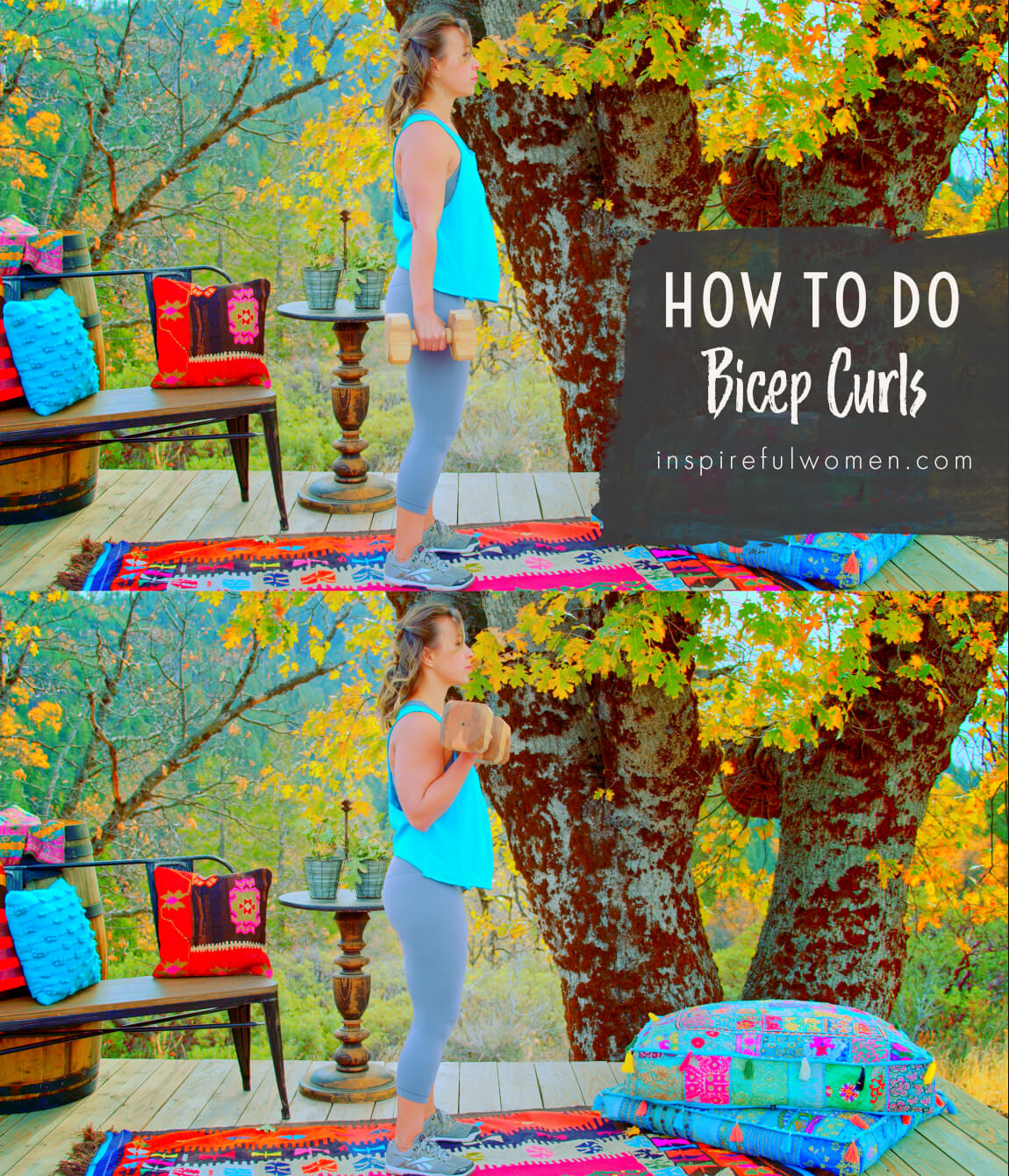

COMMON MISTAKES
COMMON MISTAKES
WHAT TO AVOID WITH THE DUMBBELL BICEP CURLS
KEY TIP:
Guess what? Good news! Many avoids are the same for most movements. Once you learn the basics, there's really only a few extra avoids for each individual movement.
1. Avoid Allowing Elbows to Come Forward/Up
AVOID: Avoid elbows going behind your body.
WHY NOT?
- This will decrease the work being done by the muscles of the arms
WHAT TO DO:
- Keep elbows stationary.
2. Avoid Leaning Backward or Forward
AVOID: Avoid leaning back or shifting your weight.
I was guilty of trying this strategy myself at first - it can seem like a good idea to kind of leaaaannnnn back to counterbalance yourself with the dumbbells in front of you. Butttt, according to the physical therapist who is the main content writer of this site, a slight backwards lean would only make the biceps muscles work harder if the arms were held in a bit of flexion. There are better ways of doing this with less chance of straining your low back.
WHY NOT?
- This will decrease the work being done by the muscles of the arms and upper back
- This is a common way the brain will try to make the exercise easier - using your body weight to help pull the hands up.
WHAT TO DO:
- Your chest should be squared to the front, with no rounding or rotation of the upper back.
- The shoulder blades do rotate during the movement but the thoracic spine and ribcage do not.
- The hips stay squared to the front.
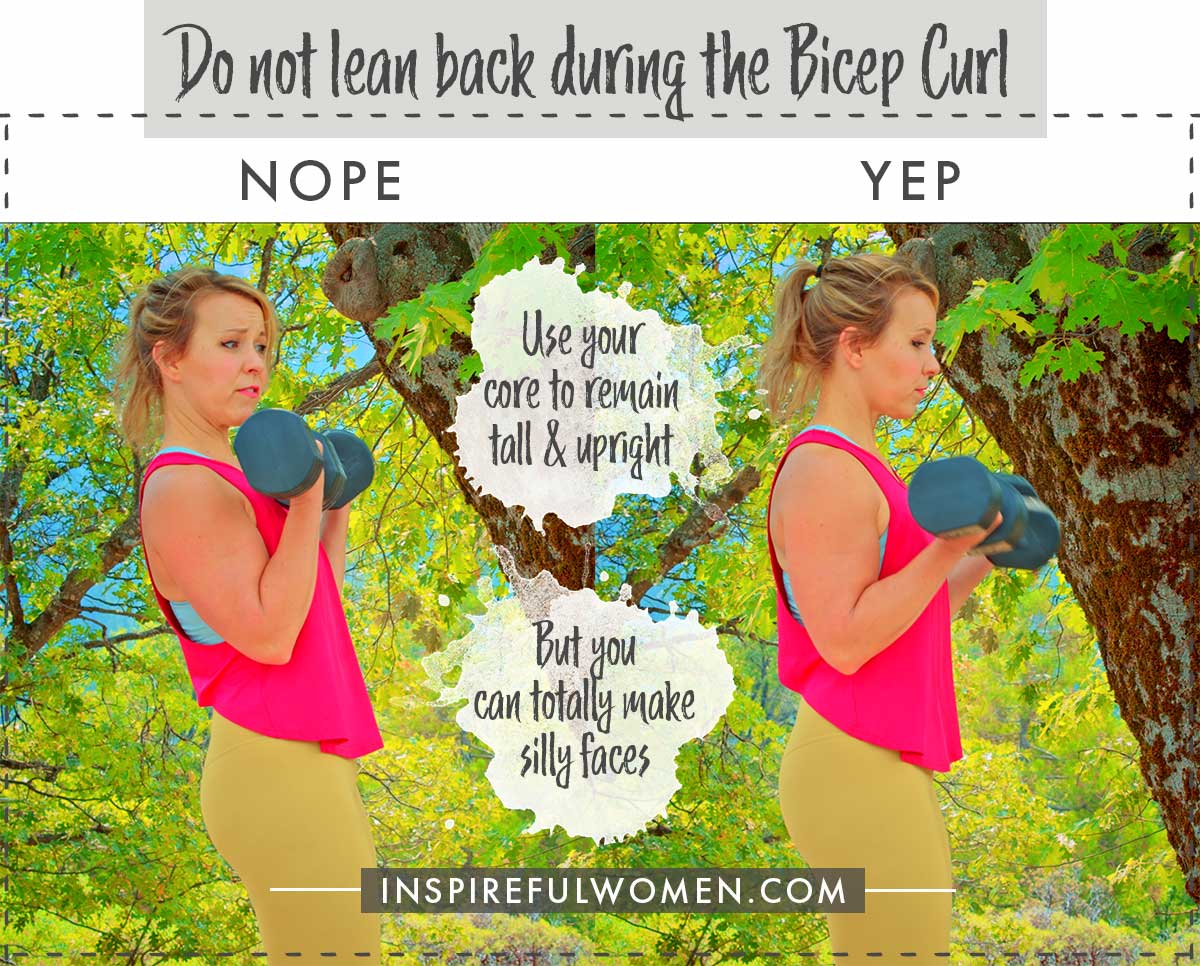
3. Avoid Shrugging Up the Weight
AVOID: Avoid shrugging up the weights.
WHY NOT?
- You're just not working the bicep muscles when you do this, that's all. This gets your upper traps (muscles to the sides of your neck where your bra straps usually lay) more involved.
WHAT TO DO:
- Pull the shoulders down to keep the space between the ear and the shoulder during the entire rep - this opens up the shoulder to avoid tendon irritation and decreases the activity of the upper traps.
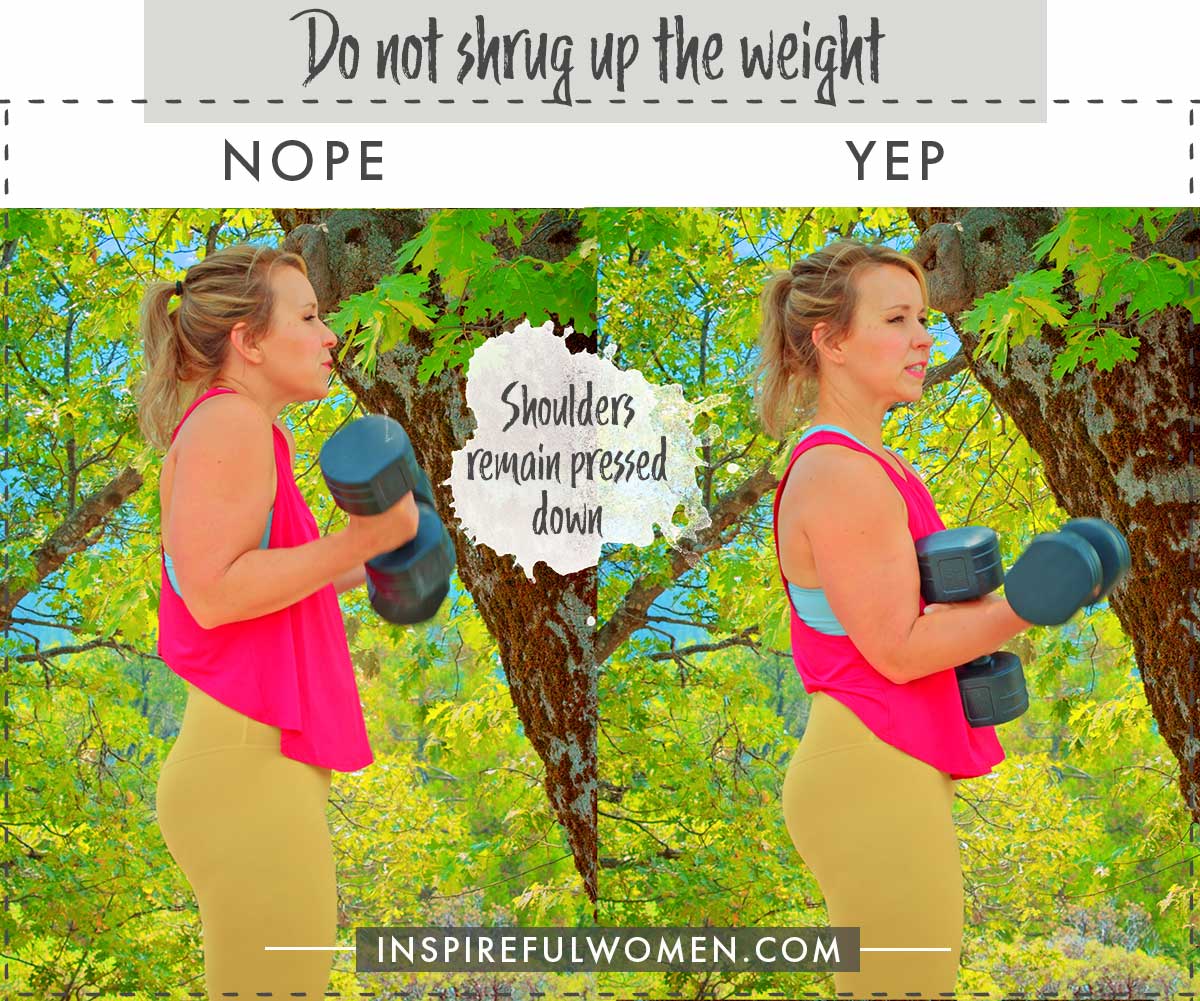
4. Avoid Flexing/Bending the Wrists
AVOID: Avoid bending at your wrists.
WHY NOT?
- This will cause the forearm to take over, working your wrist flexor muscles instead of your biceps. Additionally, since the bicep muscles are larger than the wrist muscles and you'll be using a weight more appropriate to the biceps, this could strain the wrist muscle.
- Poor alignment (bent forward or backward) or repetitive movement through the wrist can lead to joint and/or soft tissue irritation or injury over time.
WHAT TO DO:
- Your wrists should be in line with your forearm and should be still throughout the exercise.

5. Avoid Bending Chin/Neck Downward During Bicep Curl
AVOID: Avoid bending neck into weight.
WHY NOT?
- If you bend your neck down as you lift, this will put strain on your neck.
WHAT TO DO:
- If you find that you cannot disengage your neck try tightening your ab muscles.
- The physical therapists' note on this: "I believe that the reason that you bring your head forward is that the brain thinks of goals when it programs the movement. The goal is to get the weight upward. The brain tries to do this the easiest way possible. So as the muscle fatigues the brain just lowers the head downward to achieve the goal without having to lift the arms any higher. I don't think you will hurt yourself doing this (it is not like extending the neck - that would cause issues down the road) but I do think it is a compensatory motion that should be avoided because you are missing an opportunity to strengthen your core in good, healthy alignment and program healthy movement patterns."
- I was guilty of trying this strategy myself at first - it can seem like a good idea to kind of leaaaannnnn back to counterbalance yourself with the dumbbells in front of you. Butttt, according to the physical therapist who is the main content writer of this site, a slight backwards lean would only make the biceps muscles work harder if the arms were held in a bit of flexion. There are better ways of doing this with less chance of straining your low back.
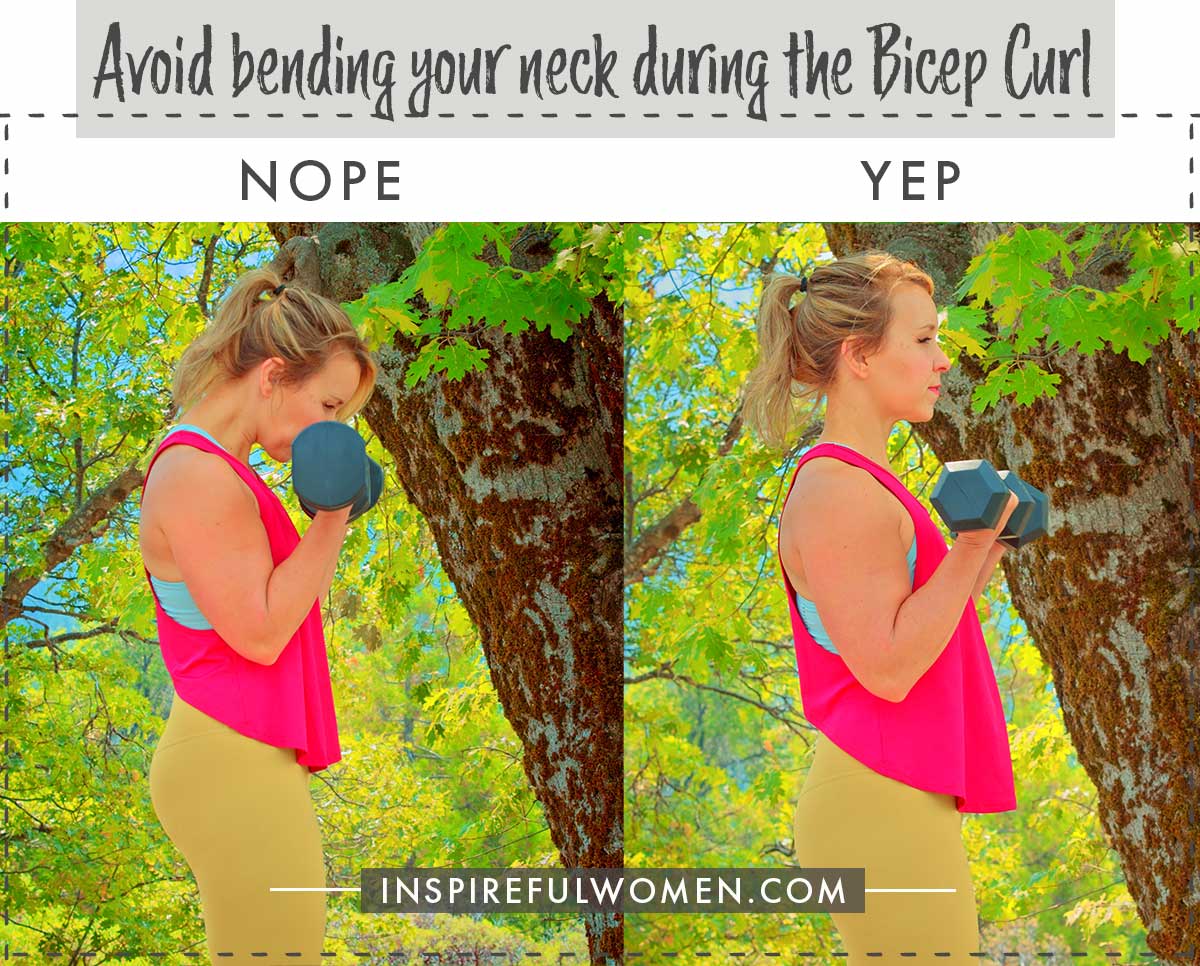
6. Avoid Swinging the Weight and/or Rocking the Body to Get Momentum
AVOID: Avoid swinging the weight.
WHY NOT?
- The goal is to have the bicep muscles doing the work- if you are rocking or swinging the weight with momentum, this takes away from that. Doing this more likely when doing the bicep curl with rotation of the arm, less likely when using the supinated version (palms up the entire time)
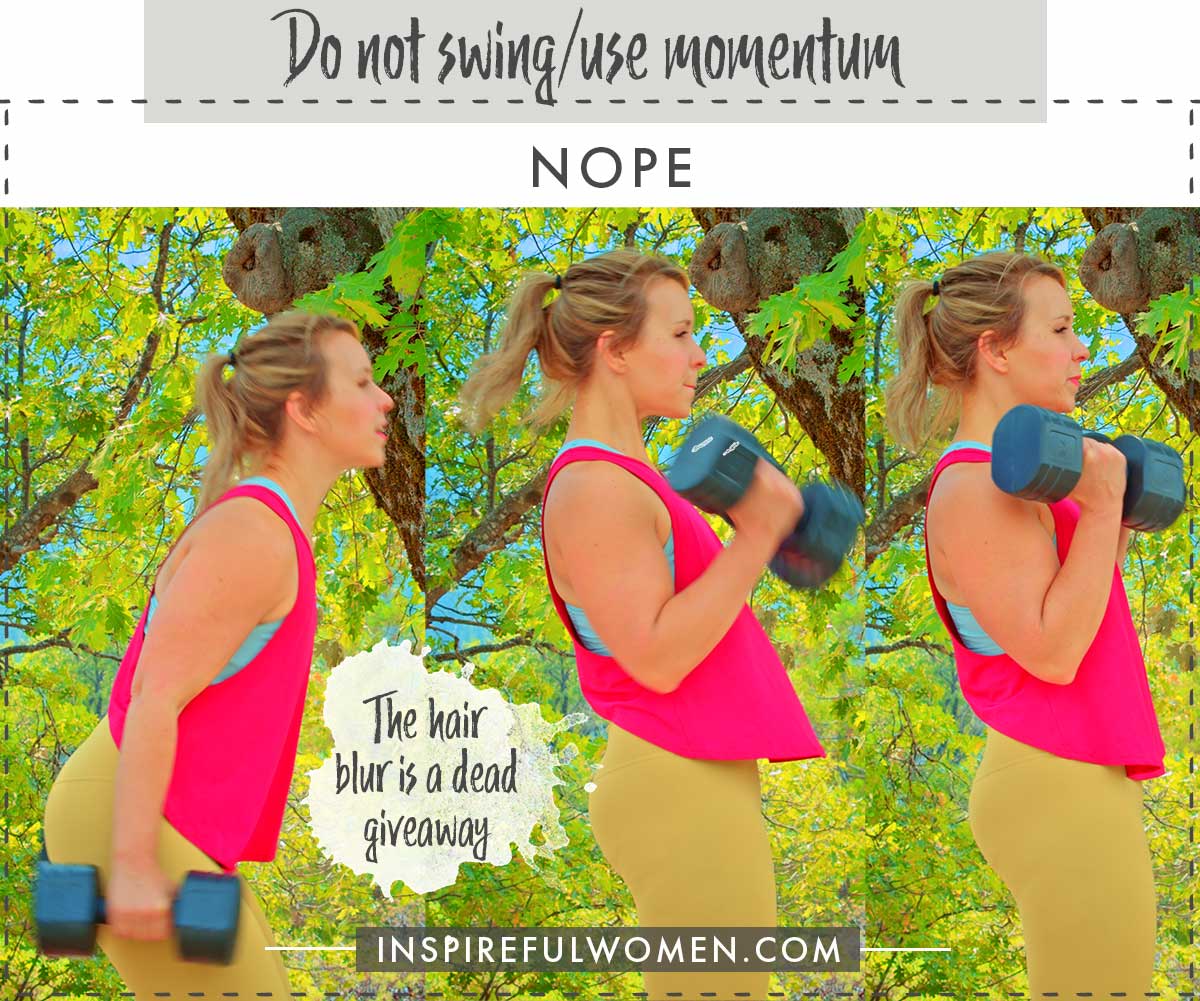
VARIATIONS
VARIATIONS
VARIATIONS OF THE DUMBBELL BICEP CURL
WIDE GRIP BICEP CURL
Wide Grip Bicep Curl
You can bring your forearms out to a 45*ish degree angle (elbows still at sides) for a more wide-grip bicep curl and this supposedly helps target more of the short head of the bicep, which is the more "ball" looking part of the bicep when it's well developed.
The standard bicep curl supposedly targets the long head of the bicep a bit more.
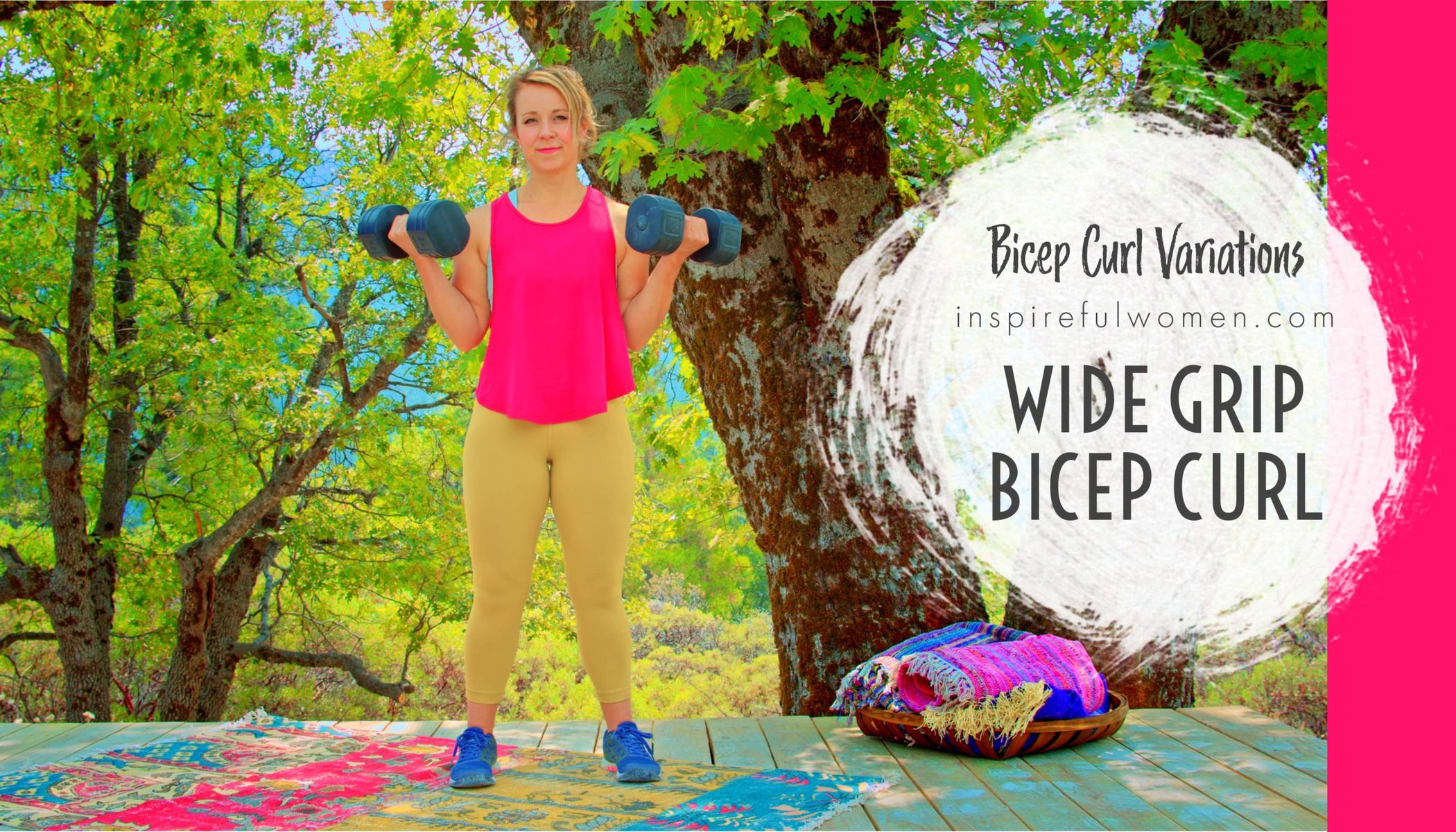
SPLIT STANCE BICEP CURL
Split Stance Bicep Curl
This is nice because it forces good posture so you can’t rock. Your back leg will be on the ball of your foot, no heel down.
This position is an easier way to keep your torso stable and still during the movement, not requiring your core muscles to work quite as hard, so this is a great option if you are struggling with that aspect of the movement.
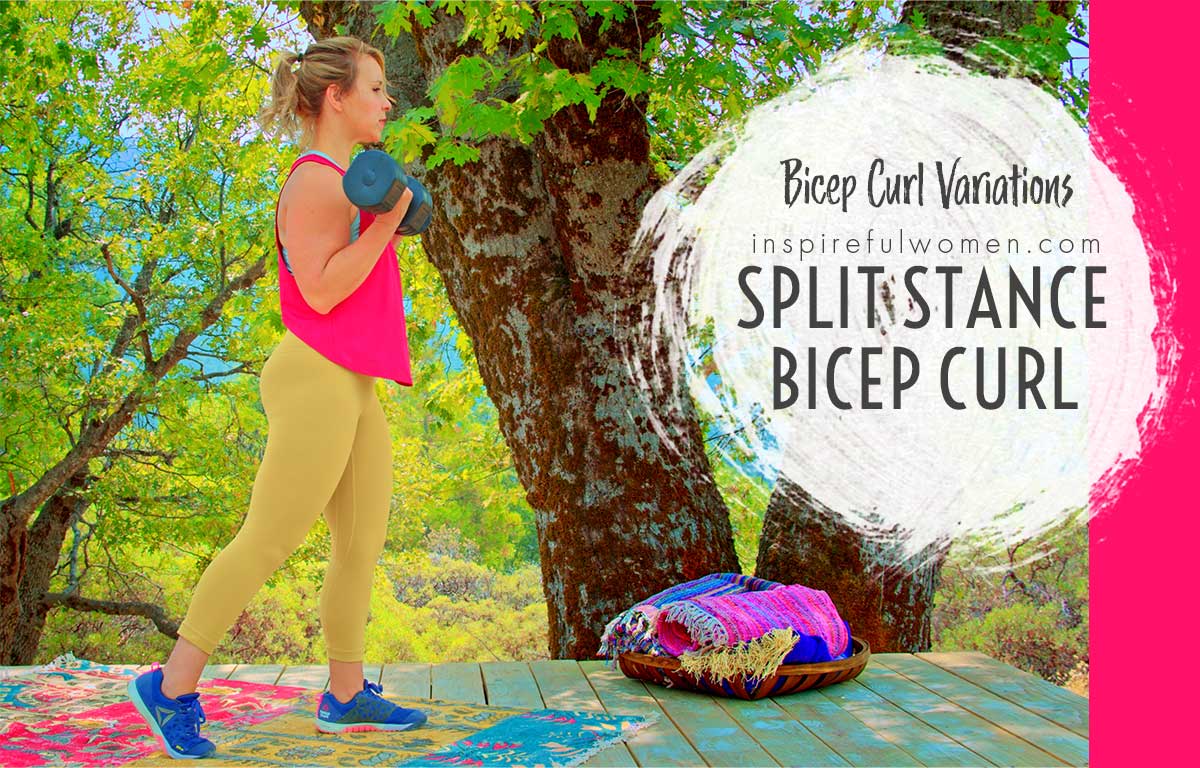
HAMMER CURL
Hammer Curl
Also called a neutral grip bicep curl, where the palms start facing each other and remain in that position for the entire time, instead of rotating the palms up during the movement as in the standard bicep curl.
This can be a more comfortable grip for some.
This version of the Bicep Curl targets the brachioradialis muscle a little more- which is......what even IS that right?
It's another muscle near your biceps in the upper arm. It's smaller but also helps you bend your elbow along with the Biceps.
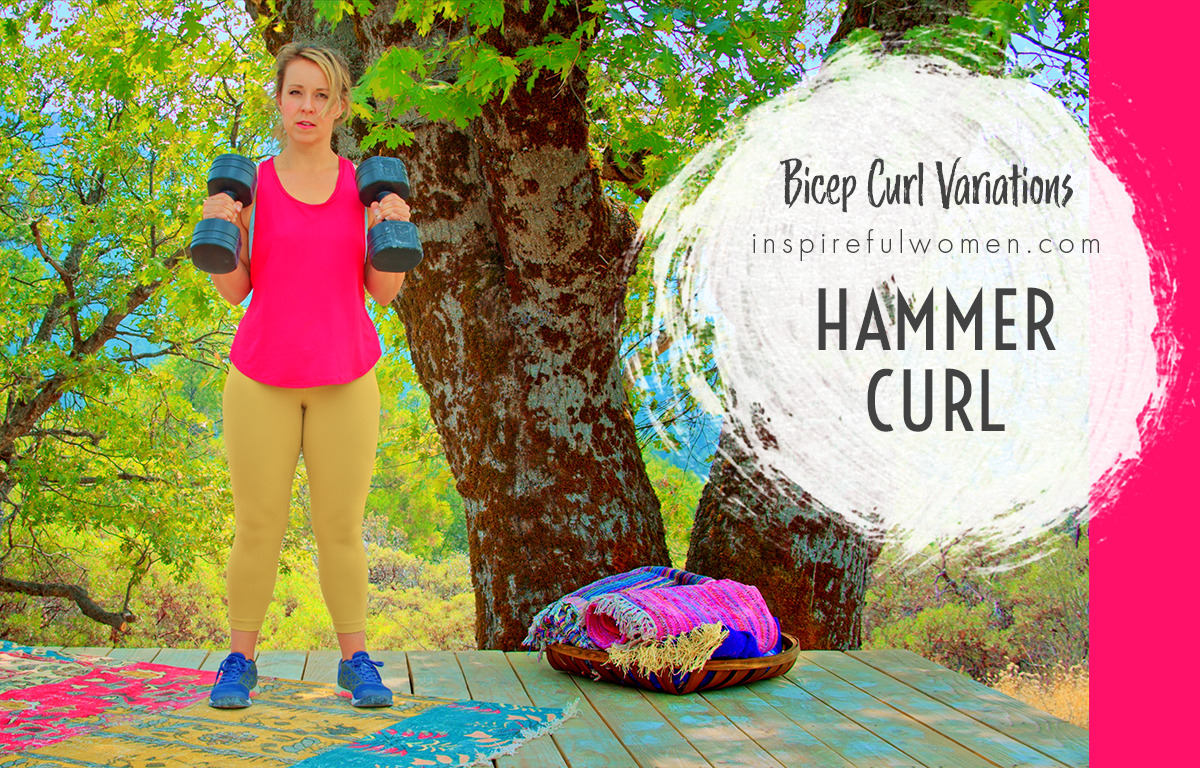
REVERSE BICEP CURL
Reverse Bicep Curl
This involves keeping your hand grip with palms facing down the entire time (called a pronated grip).
In this version, there is less bicep muscle being active compared to palms up (supinated), and you will likely need a lighter weight for this but the nice thing about this variation is that:
it will work the forearm muscles a bit more, specifically the wrist extensors (muscles that extend the wrist upward).
It is good to work the smaller muscles of the body, like the wrist because they often become limiting factors when they are not trained. IE your biceps are strong enough to carry a heavy load, but your wrists aren't.
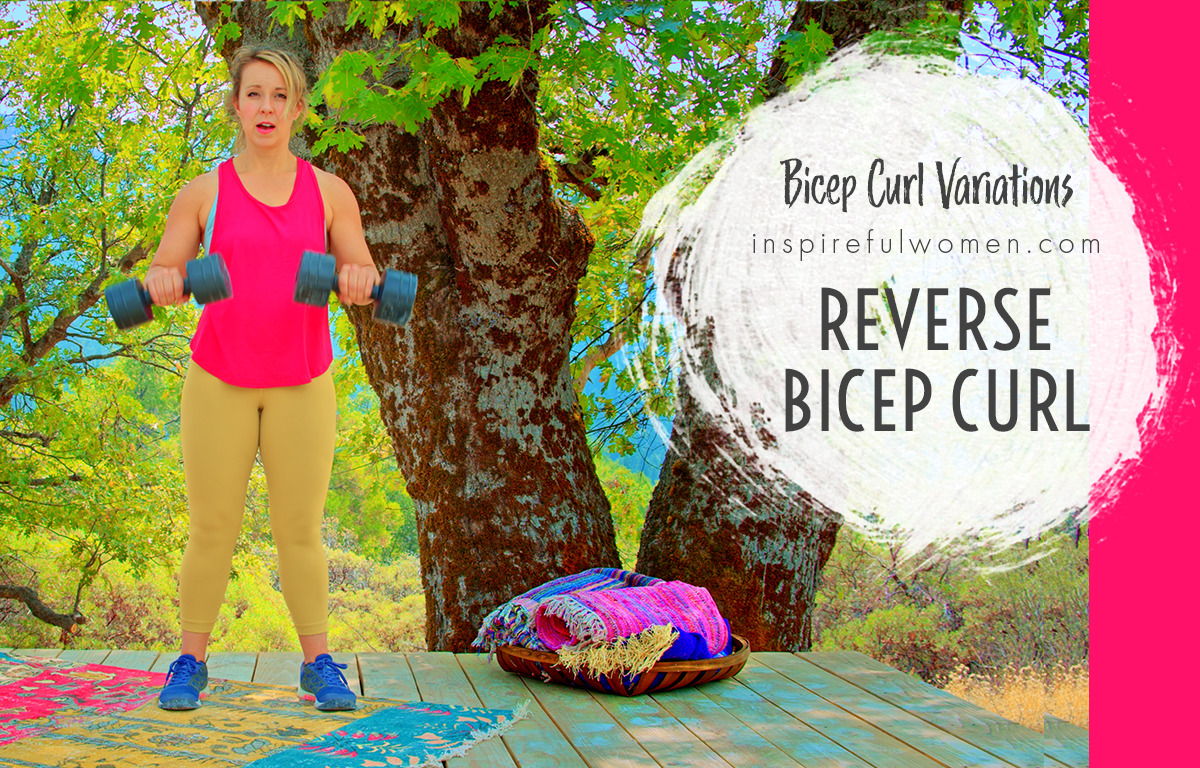
RESISTANCE BAND BICEP CURL
Resistance Band Bicep Curl
Standing on exercise band and perform the same movement.
Resistance bands are great for doing many dumbbell movements - the only trouble is sometimes getting the right amount of resistance where you feel challenged through MOST of the range of motion (so that it's not too tight on half the movement, or too loose on half the movement).
Here's some tips to try to get the right resistance for you:
- Using therabands (you can double these up to increase resistance as well) or regular loop resistance bands.
- Wrapping the edges around your hands or
- Moving your hands further in on the band
- Using bands with handles.
- Step back Eccentric curl with band- saw this where you basically tie a band low, get it taut and do a curl, then step back further with one foot back (front foot still forward) for a slow eccentric of 4-6 seconds (to make it harder) - then step forward again for the next rep for the concentric.
- Standing with 2 feet under band or 1 foot.
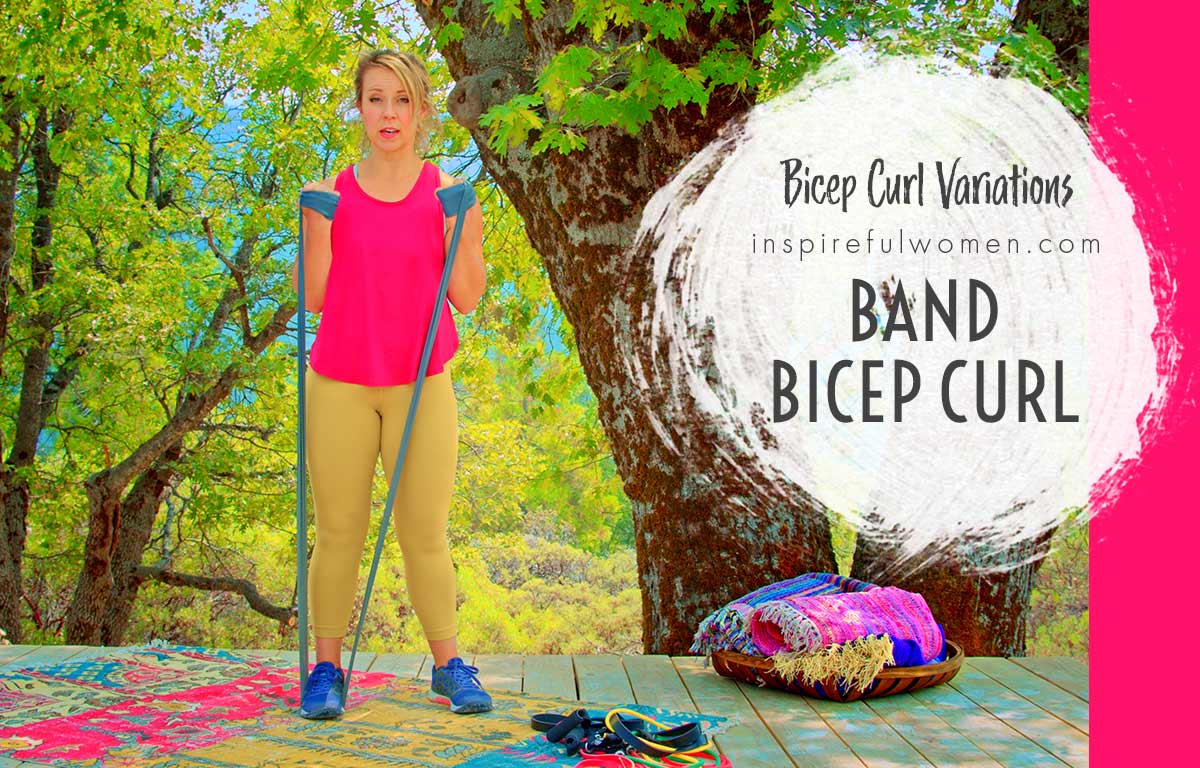
PREACHER CURL ON STABILITY BALL
Preacher Curl on Stability Ball
So this is usually done, at the gym, with an incline weight bench and all that fancy stuff. But I'm being real.
I don't think most of us have that. However, we can still do a version on a stability ball!
Rest your torso on the ball, and remember to keep your shoulders down & back in this position as well. Even though the ball is supporting your core and torso, remember to keep the core muscles gently engaged.
The advantage of this position for the bicep curl is that it puts the biceps muscle in a more stretched position from the beginning of the movement, which works the muscle a little differently.
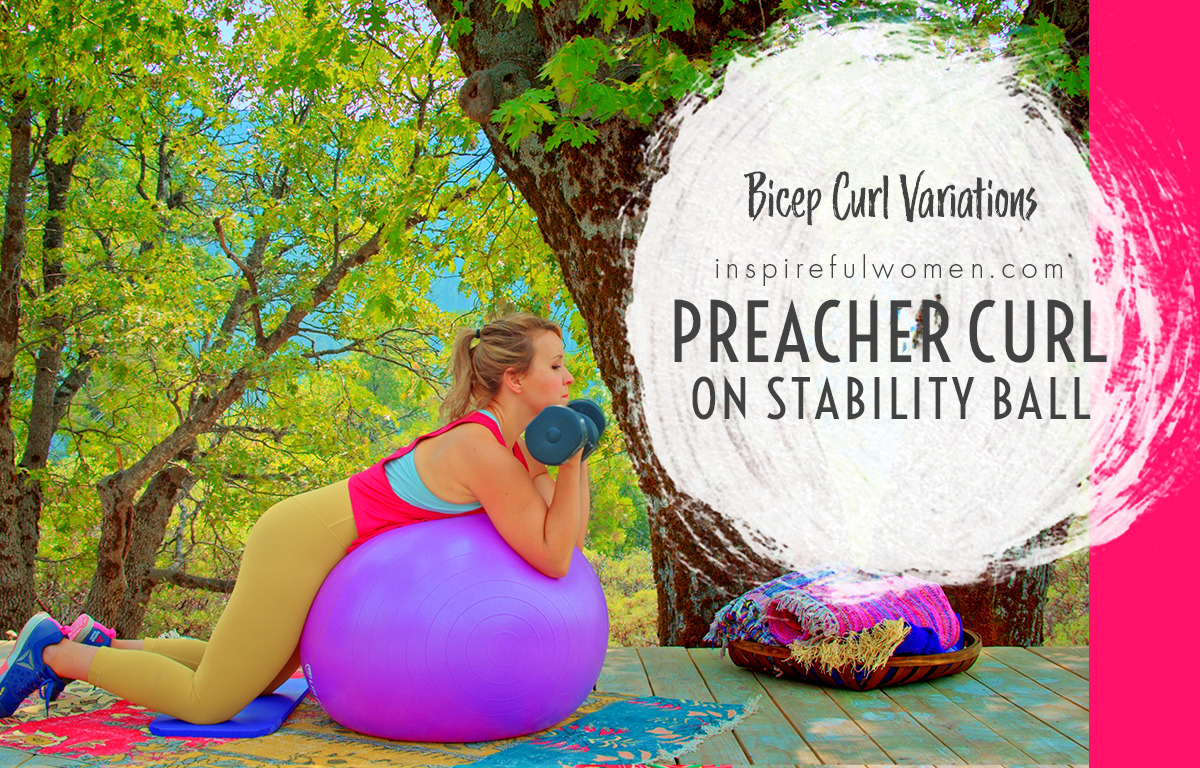
RECLINED CURL ON STABILITY BALL
Reclined Curl on Stability Ball
To do this version:
- Sit on the ball to start.
- Slowly walk your feet out, so that your torso gradually comes into a leaned position on the ball.
- The starting position goal is simply for your torso to be leaned back to some degree, as you see in the photo/video clip.
- Then you do the bicep curl as normal.
Dr. Nick, a Physical Therapist who has worked with me on this project says “think it makes the person work harder because the arms are placed in slight extension, which puts the biceps in more of a stretched position. Plus there's basically no way to use momentum/cheat to get the weight up.
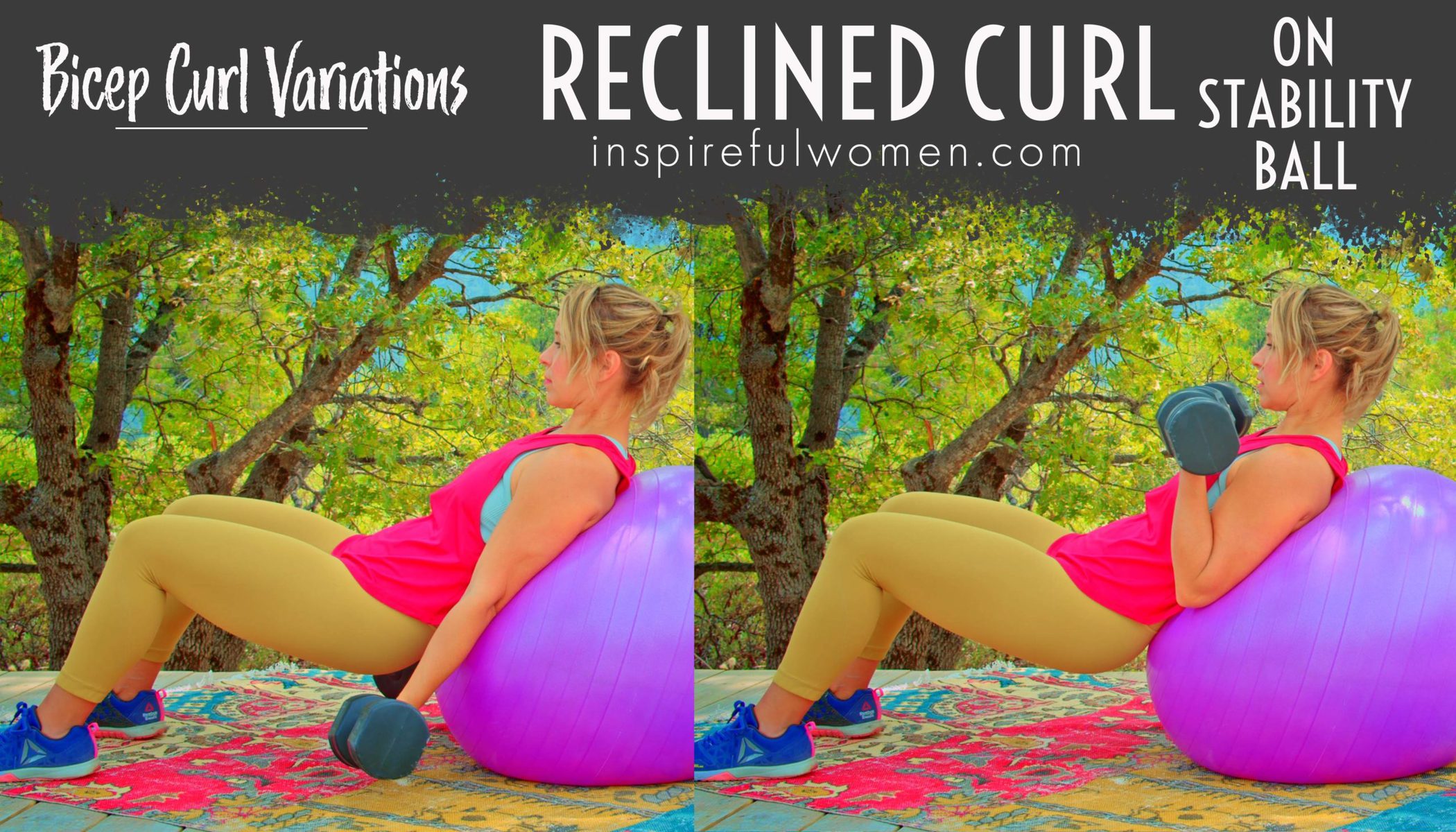
MAKE IT HARDER
HARDER
MAKING THE DUMBBELL BICEP CURL MORE CHALLENGING
“21s"
“21s” Bicep Curl
Another great tactic for making the movement more challenging while using the same weight.
The idea is you will total up to 21 reps without stopping, BUT this is how the reps are laid out:
- 7 reps in the low range - from the arm straight down to the elbow bent halfway up (90 degrees)
- 7 reps in the top half of the range - from 90 degrees to hands drawn up to chest as far as you can,
- 7 reps full range - entire range of motion - from arm straight all the way to full bend (flexion)
INCREASE WEIGHT
If your goal is to build muscle and build metabolism, than you do want to reach out for being able to gradually increase the amount of weight you are lifting.
Often, dumbbells tend to jump to quickly in weight from 1 to the next in a way that's not the best for us ladies. There are a few tips for combating this:
- Use the heavier weight for however many reps you can (say it's just 5 reps), then switch back over to the old weight amount you did before to complete the set.
- Use a band in addition to your current dumbbells at the same time, to increase the resistance of your current weight just slightly.
NOTE: In order to lift more weight in the biceps curl it is essential to increase the core strength also - you need the strong base to work off of. A lot of times what is limiting the ability to increase the weight for the biceps curl is actually that the core is not strong enough.
SLOWER TEMPO
Slow Tempo Bicep Curl (aka Eccentric Bicep Curl)
This version of the bicep curl involves doing the UP portion of the movement at the normal speed, but the down portion (the eccentric) verrrrry slowly. Count 5-10 seconds to slowly lower.
This is a great way to make the same weight fatigue the muscle much better.
I did not know and many of us ladies I think have been unaware that eccentric strength training- that is, moving slow on the downward portions of strength movements, and RESISTING that downward pull of gravity, is a very very effective way to build muscle.
Doing this method can also help you move to being able to do a higher weight at a normal pace.
WARNING: When I do my regular movements with an eccentric focus, moving more slowly on the down, I find myself more tired than usual later! I think this shows the extra demand on the muscles it can be - which is great for muscle growth, but just take note you might need a nap or go to bed earlier on days like that.
SHOULDER FLEXION AT TOP
Shoulder Flexion at Top
This version of the bicep curl will challenge the muscles a bit more by raising the elbows up a bit at the TOP of the movement (by doing this, you will be flexing aka bending/raising from the shoulder joint). This will get the long head of the biceps a bit more.
This means after squeezing the weight up as much as you can with your elbows still by your sides, you then squeeze up a little further where your elbows will now rise and come out in front of you a bit, your shoulders lifting, till the dumbbells are around eye-height. For this version, to return to starting position, it’s important to remember to do this in 2 stages - lowering your shoulders back to neutral, which will bring your elbows back in line with your body, then hold your elbows stationary at that point, so that the biceps are doing the rest of the lowering from there (if you just let your elbow kind of keep moving back behind your body, your biceps will not be doing the work for the eccentric portion of the exercise).
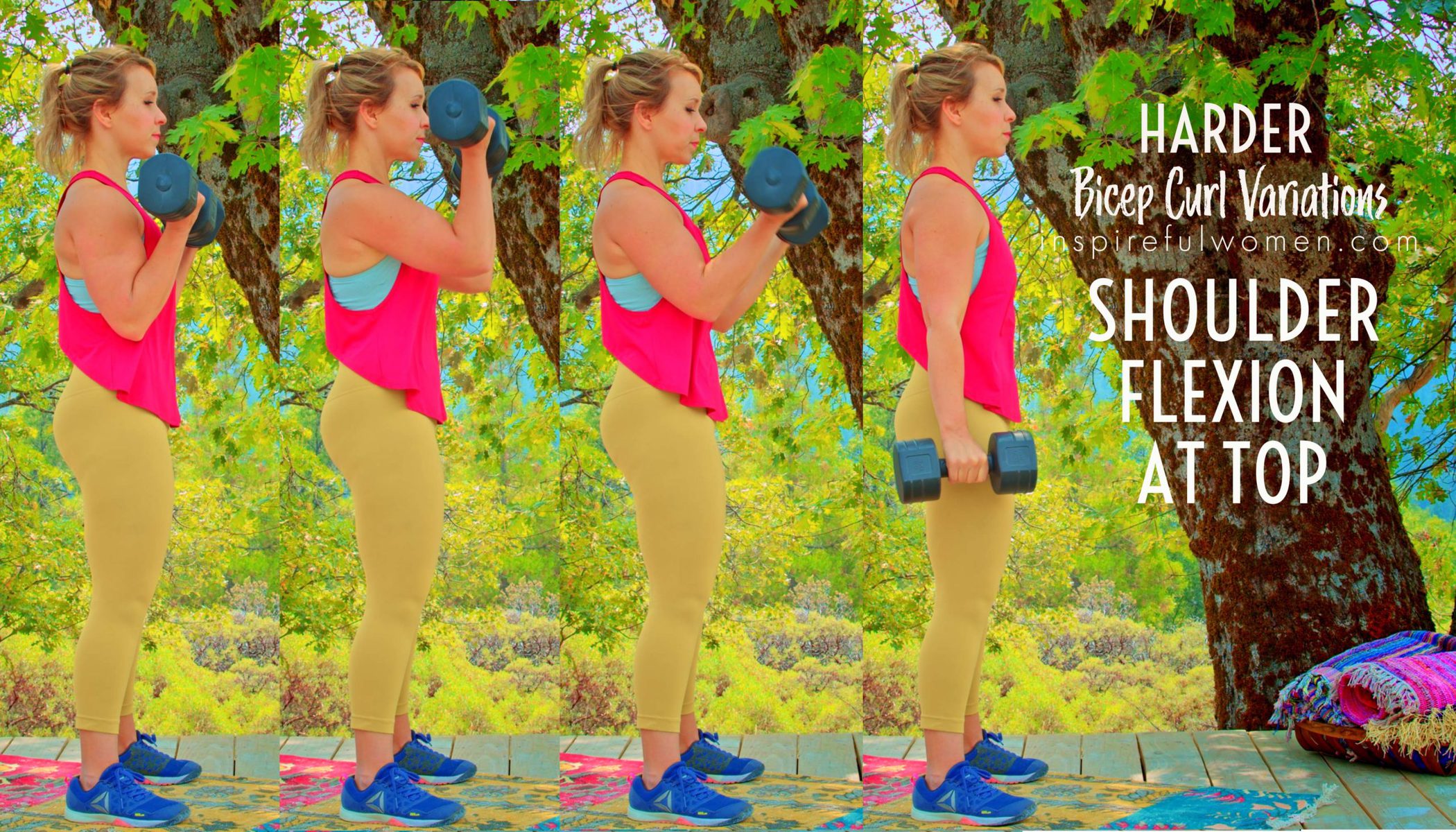
SHOULDER HELD IN FLEXION BICEP CURL
Shoulder Held in Flexion Bicep Curl
This means holding your elbow a bit more to the front of your body/torso during the movement and keeping it there the entire set.
So normally our elbows are held right by our sides in a standard bicep curl. In this case, we now move the elbows forward a bit (by doing this, we the shoulder is being held in what's called "flexion" - where the shoulder is a slightly raised position during the movement, rather than in neutral at our sides)
This positioning is more challenging because it keeps the bicep muscle under constant tension, rather than getting a bit of a break between reps. I found it quite challenging at low weights. By doing this, the weight is being held away from the body so that the biceps is under load, being challenged, from the beginning of the movement. If the weights are very heavy - make sure the wrist is able to hold a neutral position

ISOMETRIC HOLD AT 90 DEGREES
Isometric Hold
Isometric hold at 90 degrees of elbow bend (called elbow flexion) while the other arm performs the bicep curl.
RATCHETING BICEP CURLS
Ratcheting Bicep Curl
This bicep curl variation will put a lot of time under tension on your bicep muscle, which is an excellent way to fatigue the muscle, especially if you don't have a weight that's heavy enough for a standard bicep curl to feel very challening.
To "Ratchet" you will bend the elbow all the way up and then lower it about 1/8th of the way down, bend it up again and then lower it 2/8 of the way down, bend it up again and lower it 3/8 of the way down, etc
The point is you kind of seesaw the weight downward till after 3-5 times you get to the bottom position.
This isn't an exact science, just move the dumbbells up and down a little bit at a time in a way that feels good to you.
TALL KNEELING BICEP CURL
On a surface soft enough for your knees, stand on your knees to do the movement. This will require your core muscles to work harder to keep you stable and still
DUAL TO SINGLE ARM (SA)
Begin with a heavy weight doing both arms at the same time. When you reach failure (can't do any more reps), complete the set with simultaneous alternating curls - no rest at the end, but this way you are lifting half the weight so the core is able to stabilize.
MAKE IT EASIER
EASIER
MAKE THE DUMBBELL BICEP CURL MORE DOABLE
UTILIZE LIGHTER WEIGHT
It is often surprising how when we do these movements correctly, we really need less weight to get a very good fatigue on the muscle.
When using lighter weights, think about really squeezing your actual bicep muscle at the top of each rep. Studies shows more muscle development in individuals who purposefully mentally thought about squeezing their bicep muscle, than those who were not cued to do that.
ALTERNATING BICEP CURL
When just using 1 arm instead of 2, it’s usually going to feel easier, even at the same weight. To do this you will simply do 1 rep with just your left arm, then 1 rep with your right arm, etc, until you have done the full set on both sides. This gives each arm a little pause/break between reps, so your muscle will not fatigue as fast.
KEEP YOUR PALMS FACING OUT/UP THE ENTIRE TIME
Sometimes getting that rotation of the palms during the movement can really be confusing. It’s okay to just keep the palms out the entire time. In this case the only movement that is occurring during the set is bending at the elbow, that's it.
USE ONE HAND TO ASSIST
Utilize your free hand to gently assist. Each time you start lifting the weight, use your other hand to gently help your arm up (just as needed).
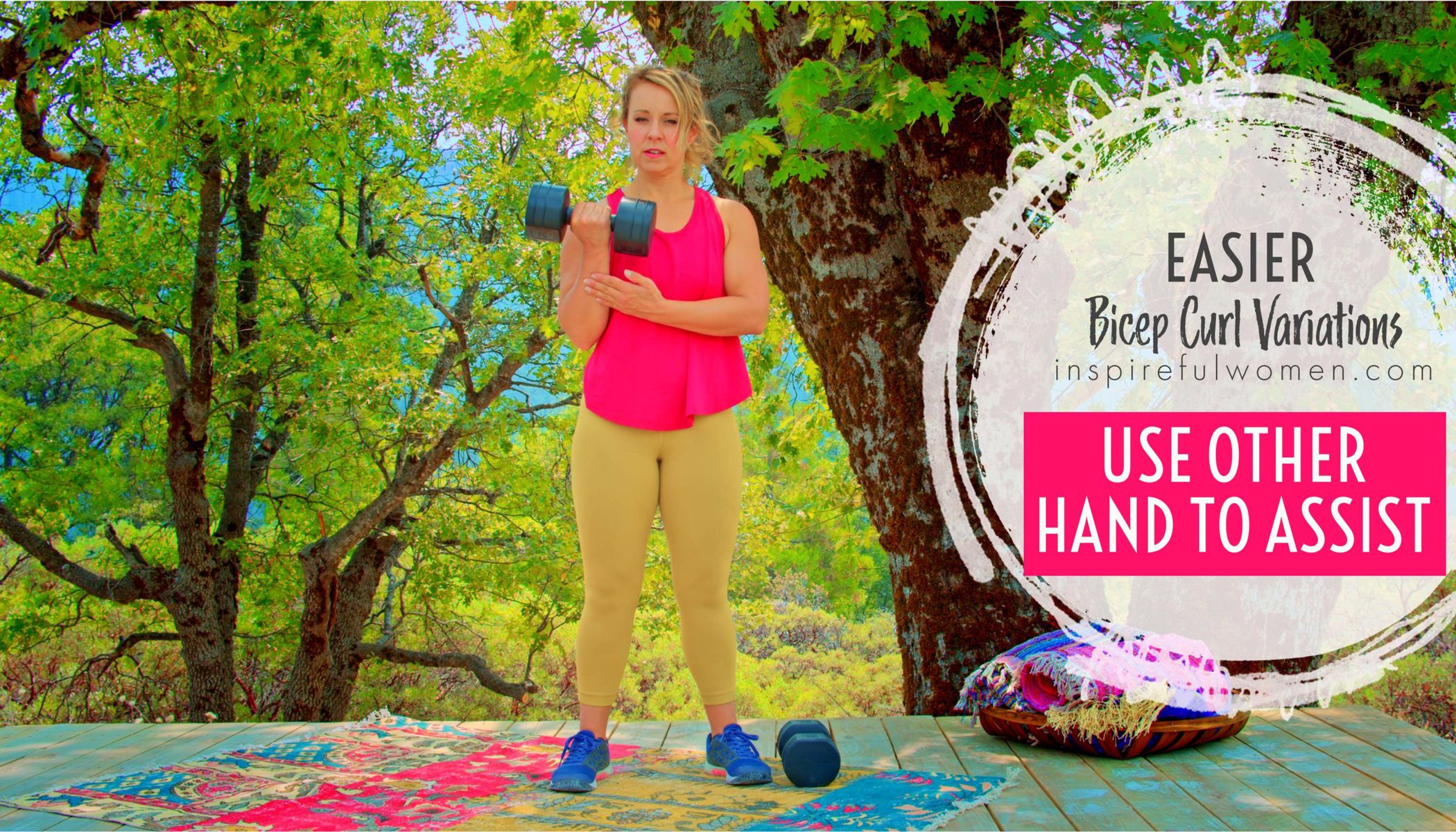
ON STABILITY BALL WITH DUMBBELLS
On Stability Ball w/ Dumbbells
Walk your feet out far enough so that you have clearance for the dumbbells. You may need to do the palms up version in this position (your palms are facing put in front at the start, instead of falling each other and then rotating).
If you bring in your legs a bit closer together, this does seem to give you a little more room to do the bicep curl next to your sides, but keep in mind will also require a bit more core activation and balance.
If you find that tricky, you can spread feet further apart- this may mean you can’t get full ROM for the bicep curl, but would give you a more stable base to work from, and you can angle your arms out more at a 45* angle during the movement.
No leaning back on the ball, keep a nice tall neutral torso.
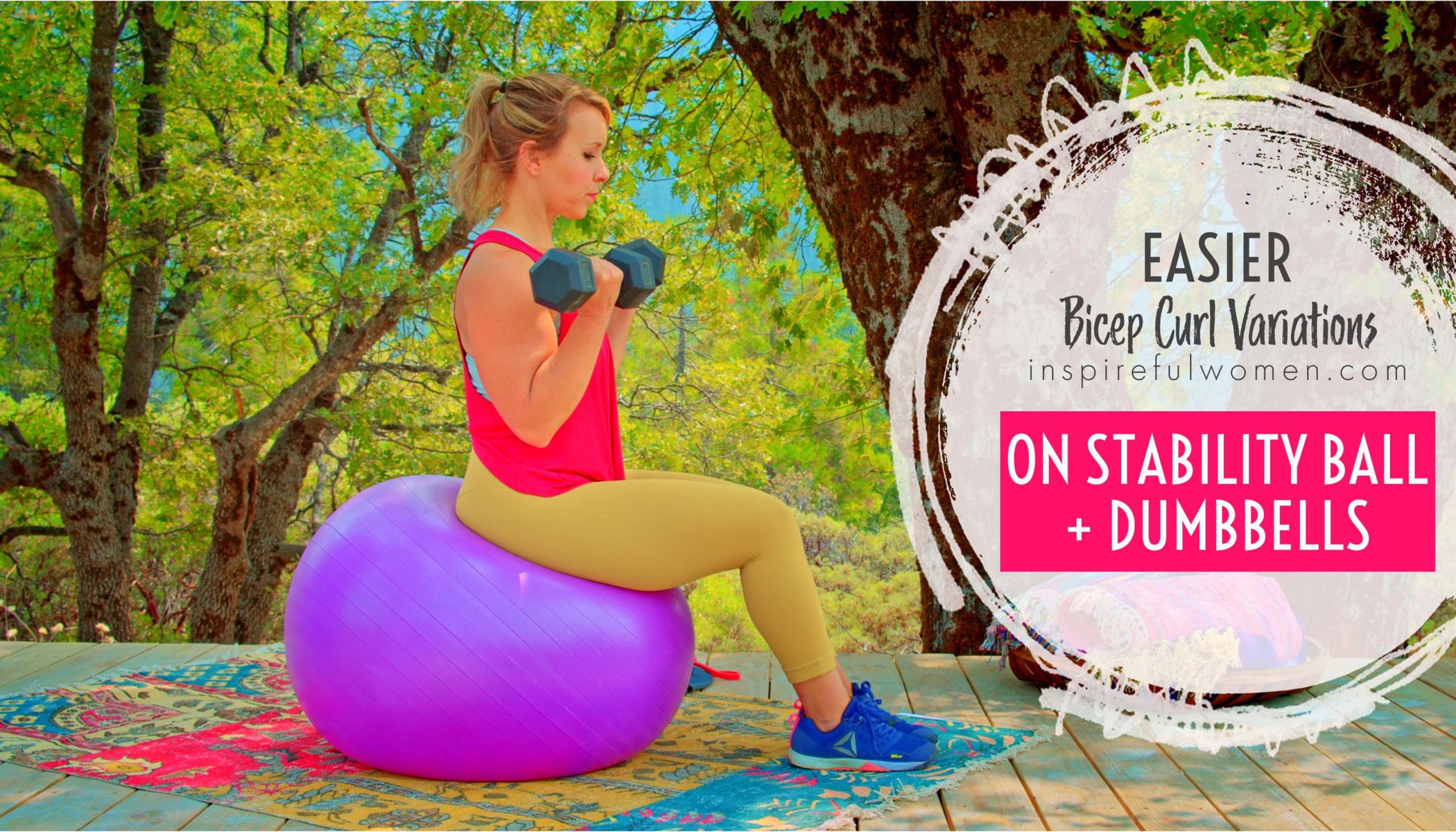
STABILITY BALL W/ RESISTANCE BANDS
Stability Ball with Resistance Bands
Band goes under your feet. You can wrap your hands around the band if that feels mor comfortable or it helps you keep your wrist from bending during the movement.
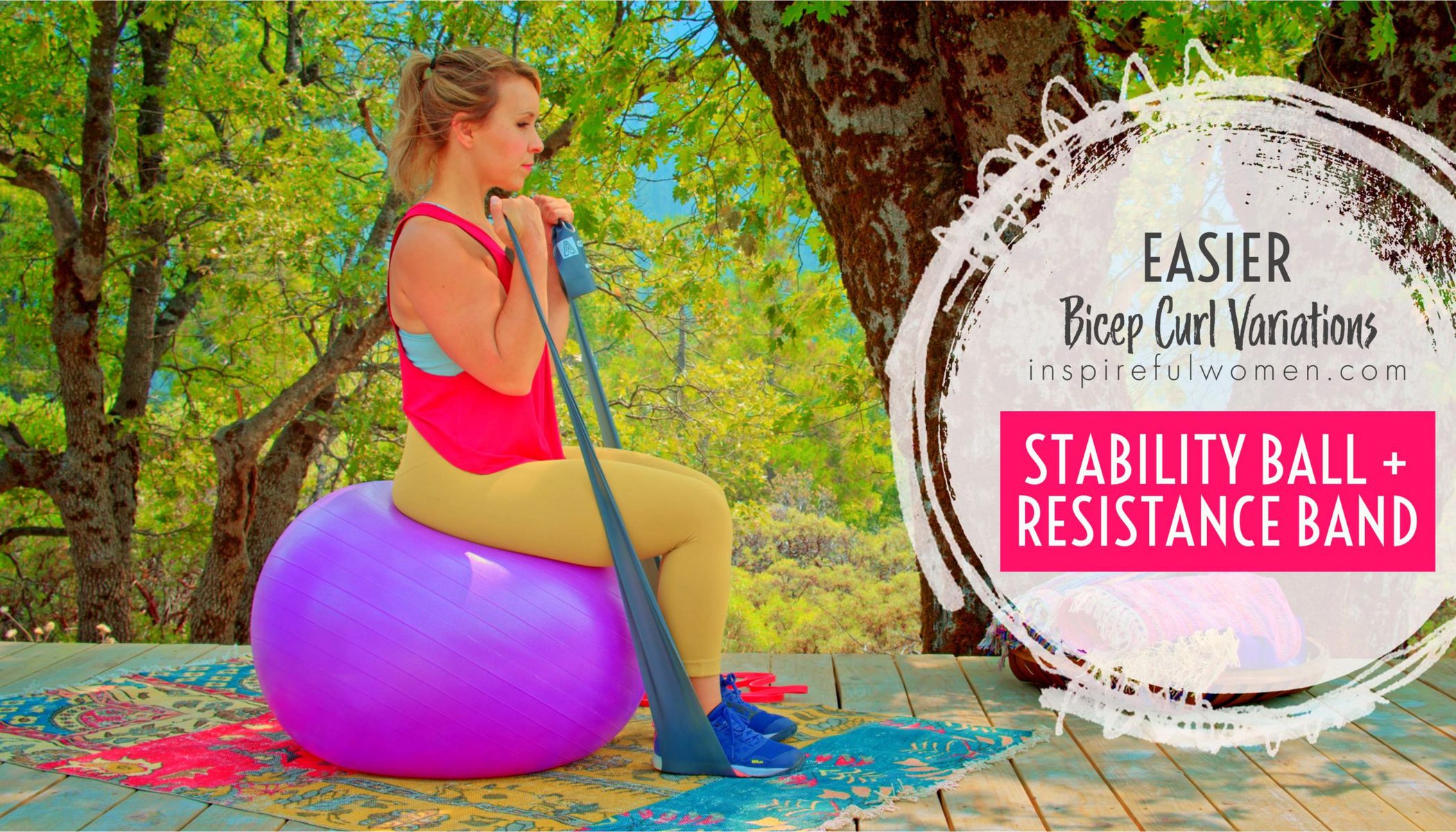
LIMITED ELBOW ROM
The idea here is to just do a partial range of motion (ROM) to 90 degrees, rather than curling all the way up to your chest.
BEGINNER NOTES FOR LEARNING MOVE IF HAVING A HARD TIME:
Start with keeping your elbows near your sides, with your palms up, and just bend your elbows, raising your palms towards your chest and do that a few times, keeping your elbows near your sides the whole time. Now try adding in a little rotation at the bottom of the movement where you rotate your palm to face your hips.
SCIENCY STUFF
ALLLL MUSCLES & WHEN
ALL MUSCLES WORKING & WHEN DURING THE DUMBBELL BICEP CURL
We can divide the bicep curl into two phases:
- Full elbow extension (arm down at side) to 90 degrees elbow flexion (forearm parallel to the floor).
- 90 degrees of elbow flexion to full elbow flexion (weight brought closer to shoulder. As mentioned above, full range of motion will give you the most bang for your buck and give you that good “pump” feeling.
PIN IT FOR LATER!
